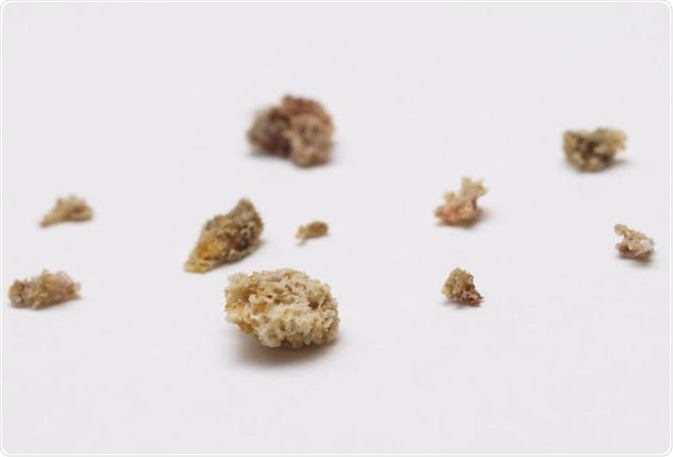
Osteonecrosis of the Jaw
Osteonecrosis of the jaw (ONJ) refers to the exposure of the jaw bone with subsequent degeneration due to avascularity, or loss of blood supply. Blood vessels are present from the periosteum (outer bone covering) into the cortex of the bone. Bone exposure is evidence of death of deeper layers; this necrosis can progress to involve nearby nerves, loosen teeth in the proximity, cause fistulas and eventually cause jaw fracture.
Skip to
- What are the causes and risk factors for ONJ?
- Clinical features
- Management of ONJ
- Can ONJ be prevented?
What are the causes and risk factors for ONJ?
In the earliest days, ONJ was reported in workers who handled white phosphorus and developed “phossy jaw”, a necrotic condition of the jaw bone due to phosphorus-induced bone erosion. Osteopetrosis is another uncommon genetic condition in which bone resorption is impaired, leading to ONJ.

Bisphosphonate-associated osteonecrosis of the jaw. Credit paparutzi / Flickr
However, today, ONJ is most often associated with:
- use of anti-resorptive medications (such as bisphosphonates) at high doses and for long periods during treatment for cancer of the bone (incidence of 1-12%). Their use for osteoporosis may also cause ONJ but much more rarely (less than 3/100 000 person years of exposure), because of the much lower dosage and much longer intervals.
- Invasive dental procedures, usually in patients taking bisphosphonate (0.1-0.3%)
- cancer treatments like radiation
- It may follow steroid use for prolonged periods or at higher dosage
- Viral infections with herpes zoster may trigger ONJ, as may osteomyelitis
- In some cases, there is no known cause.
While classically ONJ was thought to be due to sterile necrosis of the bone, due solely to lack of blood supply, today it is considered likely that bisphosphonate-related ONJ (BRONJ) is actually osteomyelitis which fails to resolve, because of the anti-resorptive effects of the medication. This prevents the infected tissue from being cleared fast enough to inhibit the spread of infection. There is evidence to show that similar inhibition of bone remodeling by other biologics also cause lesions resembling BRONJ.
Clinical features
ONJ is a condition lasting 8 weeks or more, in which a part of the jawbone is exposed and begins to die because of insufficient blood supply. The presenting symptoms may precede the visualization of exposed necrotic bone, and include pain related to infection, soft tissue edema, drainage of necrotic fluid from the wound, and the exposure of the bone. Abnormal mobility of the teeth near the necrotic site, swelling of the oral mucosa, redness and mucosal ulceration are other early signs.
Management of ONJ
While all patients with these risk factors do not develop ONJ, there is no way to tell at present which patients will be at risk. Once the condition becomes manifest, conservative management is adopted, comprising rinses, antibiotics and pain relieving drugs. Surgical debridement of necrotic tissue with wound coverage may be started early. Hyperbaric oxygen is reported to be useful.
Can ONJ be prevented?
The best way to reduce the occurrence of ONJ is to teach patients to take care of their teeth and oral cavity properly, while seeking dental checkups regularly. If patients are taking anti-resorptive medications, they should make sure their dentists know about it, so that they can take optimal measures during their dental care procedures. For instance, extractions would be preferably avoided in such patients being treated for tooth decay, a better option being root canal treatment if possible.
All teeth extractions should be followed by immediate coverage of the site by soft tissue, which prevents all cases of ONJ in this situation, compared to the development of ONJ in all non-covered wound sites when treated with a bisphosphonate.
Periodontal disease must be treated non-surgically before proceeding to surgery.
If patients are already on anti-resorptive therapy at the time of an impending dental procedure, any dental or oral problems must signal the need for a diligent examination and screening. If possible, the medication may be withheld, if not already begun, until invasive procedures on the mouth and gums are complete.
Patients on bisphosphonate for several years should consider taking a drug holiday since the incidence of ONJ in this group shoots up after this period.
Sources
- www.rheumatology.org/.../Osteonecrosis-of-the-Jaw-ONJ
- https://www.hindawi.com/journals/ijd/2014/471035/
- journals.lww.com/.../Treatment_of_Osteonecrosis_of_the_Jaw.70.aspx
- https://www.aafp.org/afp/2012/0615/p1134.html
- www.brighamandwomens.org/.../osteonecrosis-of-the-jaw-bwh.pdf
- https://onlinelibrary.wiley.com/doi/pdf/10.1002/jbmr.2405
Further Reading
Last Updated: May 10, 2019























.png)









No hay comentarios:
Publicar un comentario